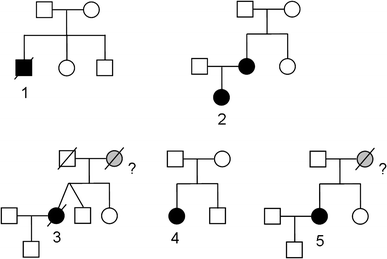Combined cardiological and neurological abnormalities due to filamin A gene mutation
- PMID: 20730588
- PMCID: PMC3022162
- DOI: 10.1007/s00392-010-0206-y
Combined cardiological and neurological abnormalities due to filamin A gene mutation
Abstract
Background: Cardiac defects can be the presenting symptom in patients with mutations in the X-linked gene FLNA. Dysfunction of this gene is associated with cardiac abnormalities, especially in the left ventricular outflow tract, but can also cause a congenital malformation of the cerebral cortex. We noticed that some patients diagnosed at the neurogenetics clinic had first presented to a cardiologist, suggesting that earlier recognition may be possible if the diagnosis is suspected.
Methods and results: From the Erasmus MC cerebral malformations database 24 patients were identified with cerebral bilateral periventricular nodular heterotopia (PNH) without other cerebral cortical malformations. In six of these patients, a pathogenic mutation in FLNA was present. In five a cardiac defect was also found in the outflow tract. Four had presented to a cardiologist before the cerebral abnormalities were diagnosed.
Conclusions: The cardiological phenotype typically consists of aortic or mitral regurgitation, coarctation of the aorta or other left-sided cardiac malformations. Most patients in this category will not have a FLNA mutation, but the presence of neurological complaints, hyperlaxity of the skin or joints and/or a family history with similar cardiac or neurological problems in a possibly X-linked pattern may alert the clinician to the possibility of a FLNA mutation.
Figures


References
-
- Sheen VL, Dixon PH, Fox JW, Hong SE, Kinton L, Sisodiya SM, Duncan JS, Dubeau F, Scheffer IE, Schachter SC, Wilner A, Henchy R, Crino P, Kamuro K, DiMario F, Berg M, Kuzniecky R, Cole AJ, Bromfield E, Biber M, Schomer D, Wheless J, Silver K, Mochida GH, Berkovic SF, Andermann F, Andermann E, Dobyns WB, Wood NW, Walsh CA. Mutations in the X-linked filamin 1 gene cause periventricular nodular heterotopia in males as well as in females. Hum Mol Genet. 2001;10(17):1775–1783. doi: 10.1093/hmg/10.17.1775. - DOI - PubMed
Publication types
MeSH terms
Substances
LinkOut - more resources
Full Text Sources
Medical
Miscellaneous

